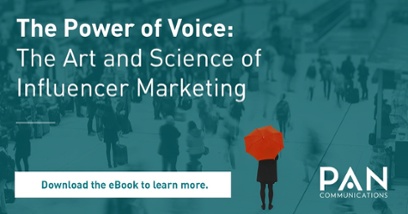How to Build a B2B Influencer Relations Program

This past weekend, I traveled to Savannah, Georgia for a quick escape from the seemingly endless Boston winter. Before traveling, I read up on Savannah travel recommendations and gathered advice from my colleague Sasha Dookhoo. One Savannah lunch spot, Mrs. Wilkes Dining Room, immediately caught my eye. Why? Obama ate there when he visited the city and there are YouTube videos of him raving about the meal. This interaction exemplifies the value of business-to-consumer (B2C) influencer relations: a well-known public figure recommending a restaurant, which ultimately entices consumers like me to visit.
The same concept applies to influencer relations when it comes to business-to-business (B2B) technology. Technology companies can use endorsements from well-known bloggers, researchers, social media personalities and other influencers in their industry to elevate their brand and increase their market recognition. However, developing those relationships can be a little trickier. Obama isn’t likely to post a video of himself using your data analytics solution, so B2B companies need to be more creative and strategic about how they engage influencers.
To help kick-start your influencer relations program, here are four B2C tactics that B2B companies can use: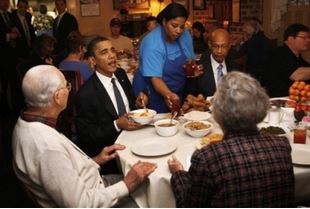
1. Identify their key communities
The first step of any influencer relations campaign should be researching the influencers you would like to engage with and discovering the types of communities they are active in. Traditional social media outlets can be a great place to start as many individuals use their profiles to showcase their passions and interests. But don’t be afraid to push the limits beyond Facebook and Twitter. Medium, an online publishing platform, is a great forum for influencers to share industry content with each other.
Mark Suster is an entrepreneur who uses Medium and Snapchat to share content about startup lessons and venture capital with his 17,000+ followers. For B2B tech companies, following Mark on his various channels is a great way to start learning about what interests him and how best to engage with him.
2. Show interest in their interests
Once you’ve identified communities that your influencers are active in, start sharing content that is relevant to solidify that relationship. Influencer relations is not sales, so make sure the content you’re sharing with your influencers isn’t overly promotional and offers educational information.
Brian Sutter, director of marketing for Wasp Barcode Technologies, calls this the “Teach, don’t sell” approach that companies should use when creating content and promoting it. If your content offers value to their audience, your influencer target is much more likely to share your material and engage with you. Jay Baer, author and marketing expert, is constantly connecting and sharing educational content with his network and it leads to interactions and collaborations with other influencers like the one below:
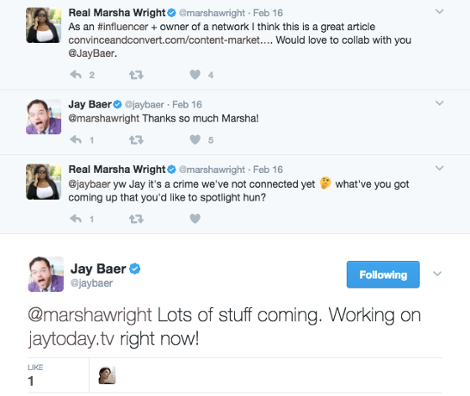
Photo credit: Jay Baer’s Twitter
3. Don’t give up – constant engagement is key
Building a connection with an influencer isn’t a onetime touchpoint. It takes constant engagement to develop the relationship, with the goal being that these influencers will eventually share your content on their channels.
Sangram Vajre, co-founder of Terminus, is someone who exemplifies strong B2B engagement practices. Sangram founded the FlipMyFunnel movement, which brings together account-based marketing (ABM) professionals. By constantly engaging with other ABM practitioners online and at MarTech conferences, Sangram turned a one-time Atlanta conference into a thriving online community of #FlipMyFunnel experts who engage with each other, share best practices and host events online and in person. If you follow him on Twitter, you can see examples of how he constantly engages with B2B marketing practitioners to maintain these relationships.
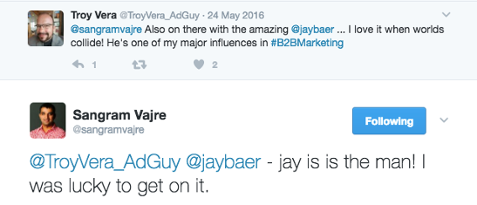
Photo credit: Sangram’s Twitter
4. Take the relationship offline
While it is great to start your engagement online, it’s important to further the relationship with in-person communication. If you notice your target influencers are attending an industry event, invite them to meet up for a coffee or to co-host a panel with you. Capitalizing off each other’s audiences is a great way to further promote both your companies.
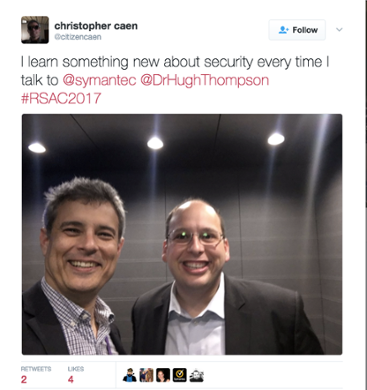
PAN’s client Symantec connecting with Publisher Christopher Caen from ReadWrite.com at RSA. Photo credit: Christopher Caen’s Twitter
Our PAN team recently attended RSA, one of the largest, global information security conferences that connects security industry leaders. A group of well-known security bloggers hosted their annual “bald security blogger” meet-up at the event to brand their unique set of skills and hairstyles. As you develop a group of influencers, consider hosting these types of expert meet-ups at events to strengthen these relationships.
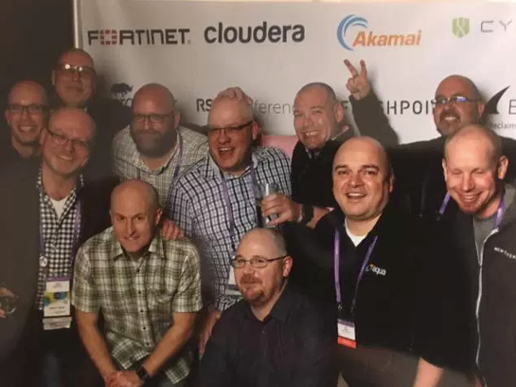
Photo credit: Naked Security
The biggest takeaway? Don’t give up. Developing a strong B2B influencer relations program takes time and the reward isn’t always immediate. However, a strong influencer relations program can lead to more industry recognition, brand awareness and market validation.
Do you have a great example of an influencer relations campaign? Share it with our team.
